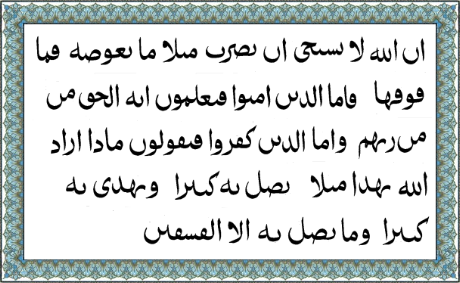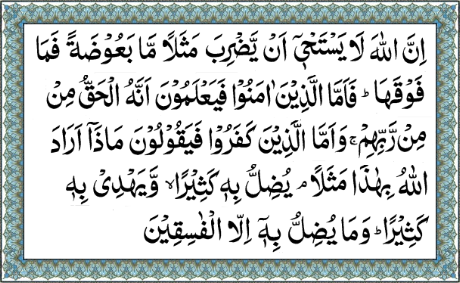MODERN ARABIC IS NOT SPOKEN ARABIC
♦ What's the deception behind using the 'modern' expression?
Arabic teachers in the west have resorted to this deception in order to falsely attract students. The majority of students in the west only want to learn how to communicate in Arabic. They sign up believing that 'modern Arabic' implies 'spoken Arabic'. The truth is that Modern Arabic has absolutely nothing to do with spoken Arabic.
♦ So, what is modern Arabic?
We have three types of Arabic: archaic, modern, and spoken Arabic.
1- Archaic Arabic:
This is the Arabic that the Qur'an was written in. In its early stages, the Qur'an had three major setbacks which made it hard to read by non-Arabs.
First, the early versions of the Qur'an consisted of many letters that had the same shape and form. That means one letter could stand for two or three actual letters that didn't relate to each other in sound. For Arabs, it wasn't big problem because they were able to deduce the proper sound based on the context. For non-Arabs, who didn't understand the meanings, it was a daunting task to read the Qur'an.
This is how it looked:
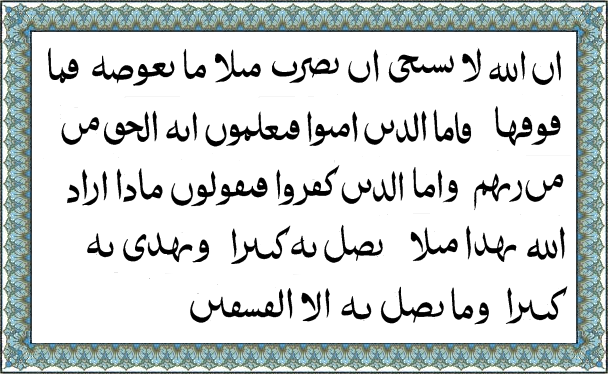
In this illustration we can see that the 'b', 't', and the 'th' are represented by the same letter.
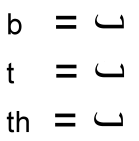
One dot was added under the letter to represent the letter 'b'. Two dots were added over the letter to represent the letter 't'. And, three dots were added over the letter to represent the letter 'th'. It was actually a brilliant idea by the early Arab scholors. The problem of similar letters was solved, and the Qur'an was a little easier to read.
Here is the same text with dots:
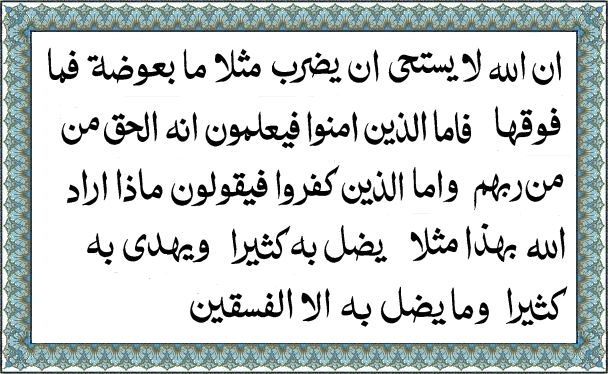
Second, the primitive Arabic alphabet consisted of consonants and no vowels. Again, this presented a huge problem for non-Arabs. Vowels are essential and without them it was impossible to read correctly. This prompted the early Arab scholars to come up with another brilliant idea: the symbols. Various symbols were added over or under the letters to compensate for the missing vowels.
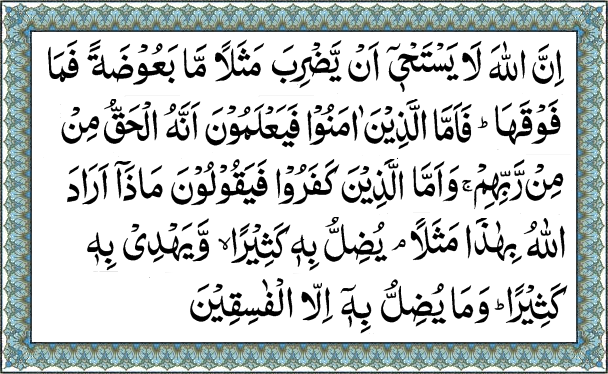
Third, the Quranic verses lacked punctuation. This problem wasn't dealt with, and until today the text in the Quran doesn't have any form of punctuation. It's hard to tell where a sentence ends and where a new sentence begins.
2- Modern Arabic:
Modern Arabic (also called fos7a) came to solve the punctuation issue. The period was added to the end of sentences. But, even with the introduction of the period, the Arabic sentences still tended to be long and complicated. The comma is rarely used. The question mark is used, but the colon, semi-colon, or exclamation mark are never used.

This is an example of modern Arabic which is really called written Arabic. In this long passage, the period and the comma were only used once. The period solved part of the problem, but the punctuation dilemma still exists.
Modern Arabic also has a lot of setbacks:
First, modern Arabic is only used for writing or documenting. Books, newspapers, and magazines are all written in modern Arabic. It is not, and will never be used for communicating.
Second, modern Arabic dropped the vowels or symbols. This made it extremely difficult to read and learn. The reason for that is that adding symbols requires extensive knowledge in the Arabic grammar which is full of exceptions. It requires too much time and skill. It's not an easy process.
Third, the time a student will need to master modern Arabic is at least six years. And, at the end of those six years, the student will be able to read and write in Arabic, but will not be able to communicate.
3-Spoken Arabic:
Spoken Arabic is the easiest to learn and requires very little time. But, it too has a lot of setbacks:
First, the biggest problem facing spoken Arabic is that we have so many Arabic dialects. Almost every country has its own dialect. You have the Lebanese dialect, the Saudi or gulf dialect, the Egyptian dialect, and the Moroccan dialect. Which one should a student choose?
The most common Arabic dialect in the 80s and 90s was the Egyptian dialect. Egypt was the biggest Arabic country, and it was the Arabic leader in many ways. Recently, Egypt as a country lost its role as the leader of the Arab world. It politically crashed and is barely surviving as a country.
The second most common dialect is the Lebanese dialect. After the fall of the Egyptian dialect, the Lebanese dialect rose to the occasion and filled the gap. It is now the most popular and understood dialect in the Arab world.
The second biggest problem is resources. Aside from my books, spoken Arabic isn't documented. That's why teachers have a problem teaching it. When I started teaching Arabic in Canada, I was faced with the same problem. Students would register and then leave after a few lessons because they were told by their Arab friends that this is not spoken Arabic. I had to come up with a solution: I started writing my own books. So far, I wrote 20 books related to spoken Arabic.
LIGHTHOUSE OF THE ARAB WORLD
Literacy plays a huge role in determining how advanced a country is, or even a culture. According to UNESCO, a literate individual is one who has completed grade 5. And, based on this definition, Iraq was 78% literate in 2015. Saudi Arabia was 97% literate. Kuwait is 93% literate. Egypt is 74% literate. And, Lebanon was 89% literate.
When talking about literacy, Saudi Arabia and Kuwait seem to be the lighthouse of the Arab world. As an Arab, I know that this is not true at all. It's not even close to being true. Knowing how to encrypt 28 Arabic letters used to be literacy 50 years ago, but not today.
The term Literacy needs to be redefined in order to reflect the true image of progress in the Middle East. According to me, literacy is the ability to read, understand, weigh, and conclude. Reasoning and thought is what defines literacy in the 21st century.
Reasoning and thought should be at the core of our educational curriculum. Having a personal opinion about something should be encouraged in classes. Asking a student for his/her personal opinion should be the basis of education in the Middle East. This is how the western modern civilizations were established.
As an Arab, and based on my personal experience and observation, and based on my new definition of literacy, I believe that Lebanon is 15% literate. Egypt is 5% literate. Syria, Iraq, and Jordan are 1% literate. Saudi Arabia and Kuwait are less than 0.001 % literate. That is 1 out of every 10,000 Saudi citizens are considered literate. Saudi Arabia was never and will never be the lighthouse of the Arab world. The reason is that freedom of speech is not permitted in Saudi Arabia. Independent thinking is not allowed. Free thought is severely prosecuted.
In 2014, the Human Rights Organization called for the end to the oppression of thinkers in Saudi Arabia. There are more than 40,000 political prisoners in the kingdom. All the religious disputes and conflicts in the Middle East are instigated by Saudi Arabia.
Raif Badawi is a Saudi writer and the creator of the website Free Saudi Liberals. In 2013 he was convicted on several charges related to encouraging free thought on the internet, and was sentenced to seven years in prison and 600 lashes. In 2014 his sentence was increased to 10 years in prison, and 1000 lashes by the lighthouse of the Arab world.
THE ROPE IS ABOUT TO SNAP
There's an Arabic saying that goes like this: the tighter you pull on a rope, the more likely it will snap. This explains what is happening in the Middle East, and what is about to happen in the near future.
During the 20th century, the political and religious elite had full control over every single aspect of our lives. By instigating religious disputes, and separating Arabs into political and religious camps, the controlling elite were able to maintain their power over millions of Arabs who were manipulated like sheep.
Even the Arabic culture contributed to the elite's agenda. A lot of it is based on being submissive and tame. We were taught to surrender our thoughts to the controlling elite, whether political or religious.
We watched the world evolve and change while we remained stagnant. We strongly believed that change is blasphemy, and modernization is associated with immorality. The controlling elite even mocked the west and predicted their collapse within a decade.
But, the decade passed and the west grew better and stronger. Many countries around the world accepted change and grew to be successful countries, like Japan and South Korea. Those who rejected change remained on the low level of the Arab world like North Korea and Pakistan.
The controlling elite could have maintained their dominance for hundreds of years, but the Arab world got unexpectedly lucky - the internet was introduced. It was an eye opener to the millions who were kept in the dark for such a long time. We read articles and watched YouTube videos. For the first time, we saw real debates, and we heard both sides of the story. We were shocked.
Of course, the controlling elite panicked and tried their best to filter unwanted YouTube videos. They invested so much effort and money only into the technology of preventing the people from seeing the truth. And regardless of all their effort, the flood of information continues to pour into the Arab world.
Everything you see today in the Middle East is just the last phase of the power of the controlling political and religious elite. All the turmoil and wars are just the last episode of the dark ages. The rope that has bound the Arabs for so long is about to snap.
CLINING TO A FAILING HERITAGE
Why are newcomers to the West clinging more tightly to the failing heritage they left behind? Why are they afraid of letting go?
This phenomenon is so clear when you visit a mall in the west. You will easily distinguish different cultures – not by the color of their skin, but by the fashion of clothes they are wearing. While this phenomenon doesn't seem obvious when males are concerned, it is definitely obvious in the female population.
Now, I have absolutely nothing against different fashions or types of clothing. But, most of what we do in life has a purpose, unless it's a coincidence. Personally, I don't believe in coincidences. I believe that there's a statement behind everything we do.
When my grandfather first arrived in Canada, my uncles and aunts went to meet him at the airport. They were shocked to see him still wearing the Lebanese shir-waal - baggy trousers. This was part of a male's traditional attire in Lebanon a long time ago. Immediately, they took him to the closest clothe store and bought him regular Canadian pants. At first, he resisted a lot and threatened to go back to Lebanon, but eventually, he gave in and wore the pants. He hated them more than you can imagine, and for the longest time, he called them 'sissy' pants.
To my grandfather, the shir-waal was a symbol of manhood. He comes from a male dominant culture where men have full authority over women and children. He was the king of his family in Lebanon. By removing his symbol of manhood, he was stripped of his title and reduced to a regular human being. He didn't like that.
I can understand my grandfather resisting to let go of his dominance, but what are the female newcomers holding on to? What are they afraid of losing?
Well, it all channels back to the male dominant society. In the Middle East, the female is submissive and has no authority whatsoever. She has to be humble and obedient. She has to tolerate anything that her father, brother, or husband demands. By continuing to wear her traditional clothing, she is submitting her will to her father, brother or husband. She is continuing the tradition of being submissive. This doesn't make her happy – this makes the males in her life happy.
Changing her clothes and blending into the western way of life means she's rebellious. This is a big no-no in a male dominant culture.



